Planting basil seedlings: rules for growing and care in the open field
The high popularity of basil grown in summer cottages is largely due not only to its excellent qualities as a fragrant spice, but also to its decorative effect. And this wonderful-smelling grass is also planted to repel pests in the garden. So do not delay planting it, because early basil can only be grown by sowing seeds for seedlings.
Next, you will learn about when and how to plant basil in willow seedlings in open ground.
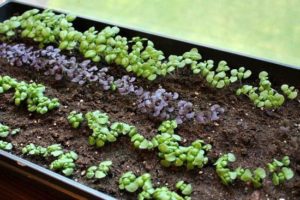
Content
Planting basil seeds for seedlings: varieties, timing, necessary container and soil
The most popular basil varieties, depending on the ripening period, are:
- Early (40-50 days): Dwarf, Green fragrant, Pearl of the Moscow Region, Lemon and Clove;
- Average (60-70 days):Caramel, Charodey, Moskvoretsky, Orion and Vanilla Aroma;
- Late (80-90 days): Moorish, Table, Marquis, Charm and Fantasy.
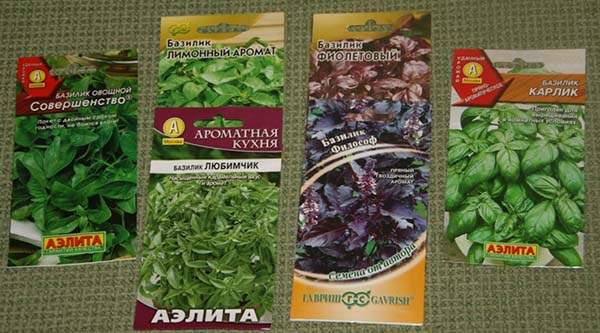
Basil also comes in green and purple depending on its color.
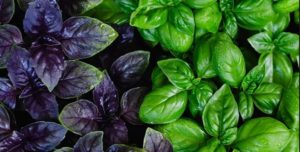
Video: how to grow basil - an overview of varieties
When to plant seedlings: depending on the region, variety, according to the lunar calendar
Basil is a rather thermophilic culture, with planting and disembarking in open ground you should not rush. Therefore, if you want to get early and high-quality greens, as well as extend the time of its "fruiting" (of course, if you regularly pinch it), it is better to first plant basil seeds for seedlings.
As a rule, you need to plant basil for seedlings about 40-60 days before the expected time of transplanting the plant to the garden.
- Why so much time?
Firstly, 5-10 days, as a rule, are spent waiting for the appearance of the first shoots, secondly, the seedlings should grow to an acceptable size - this is another 30-40 days, thirdly, if you dive, then feel free to add 5 -10 days for the seedlings to take root in a new place.
Therefore, if you live in the Middle Lane (for example, the Moscow region), then the optimal time to start planting for you will be end of March - beginning of April, just by the end of May, seedlings can be planted in well-warmed soil. If you have a warmer climate, then the terms are shifted - you can start sowing from the end of February, just by May the seedlings will be completely ready.
The cultivar also has a noticeable effect on the timing of sowing basil on seedlings. So, it is better to plant medium and late varieties earlier, but it makes no sense to rush with the early ones, because overgrown seedlings do not take root well in a new place, and if you plant it ahead of time, it will simply freeze and will not accept.
According to the lunar calendar in 2021
Choosing the best date for sowing a crop can help you Moon calendar.
Auspicious days according to the lunar calendar for the planting of the basil in 2021 are:
- March - 2-8, 26-29;
- April - 1, 2, 11-15, 17-20, 25-30;
- May - 2-4, 6, 9, 10-12, 15-17, 20, 21, 25-29;
- June - 2-4, 7-9, 11-14, 16-19, 30.
But you should also take into account the days New moons and Full Moon, since when sowing at this time the seedlings will turn out to be weak and elongated, as well as the period when the Moon is in Aquarius, because it is a barren and dry sign -italicized... Therefore there are unfavorable dayswhen to plant the basil tonot categorically, in 2021 it:
- in March -9-10, 13, 28;
- in April -5-6, 12, 27;
- in May -2-4, 11, 26, 30-31;
- in June -10, 24, 26-27.
Tanks and soil
When choosing a container for sowing basil, first of all, think about how much you need it and where you will put it. If you have a lot of space and want to grow a big crop, then plant in large wooden or plastic boxes, special seedling trays. Peat tablets and the most common disposable cups, used sour cream, yogurt containers or milk cartons are also suitable.
To successfully grow basil seedlings, you need loose and light soil, in other words, it must be nutritious and breathable.
As always, you can buy soil for seedlings at a garden store or get a little confused and prepare yourself.
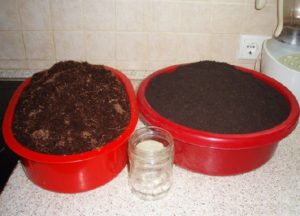
The optimal composition of the soil mixture should consist of the following components:
- 2 parts humus or well-rotted compost;
- 4 parts of peat;
- 1 part sand.
You can also use the following soil mixture:
- 1 part of garden land;
- 1 part peat;
- 1 part humus.
The resulting substrate must first be sieved (so that there are no lumps in it), and then disinfect (for example, steam in the microwave or spill with a fungicide, the same Fitosporin or in extreme cases - potassium permanganate). 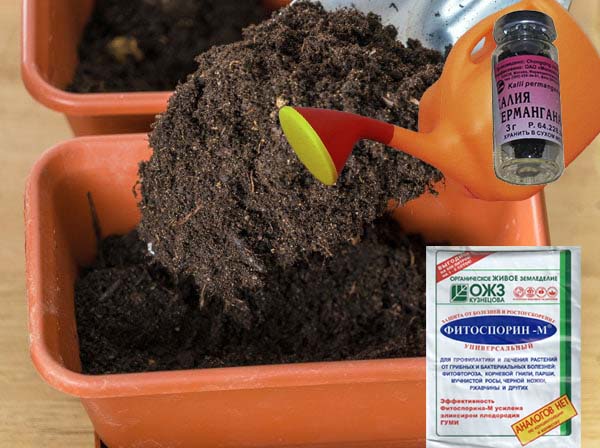
When using ready-made store-bought soil, it is enough just to spill it with a saturated solution of potassium permanganate or even better with a bio-fungicide Fitosporin.
Planting methods
For better germination, it is recommended to hold the seeds a little in one of the popular growth stimulants, for example, in "Epin" or "Zircon" (the consumption of funds and the holding time are written on the instructions for the preparation).
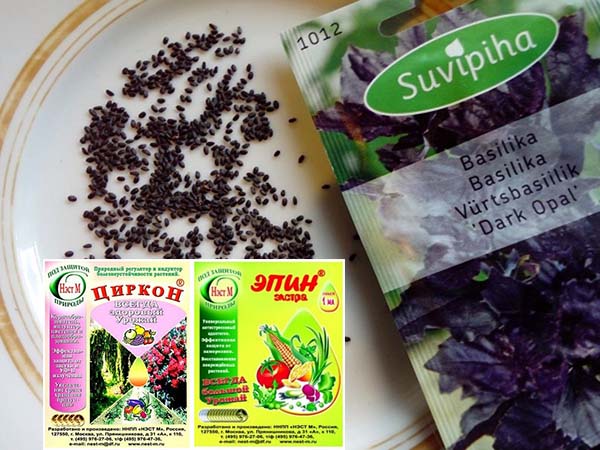
Step-by-step classic method of sowing basil seeds for seedlings:
- The planting container is filled with soil mixture by 5-6 cm, then compacted.
- The seeds are spread evenly over the soil surface.
- Lightly sprinkle with soil 5-10 mm.
- It is poured abundantly, but neatly from a spray bottle. The seeds must not be accidentally washed.
- It remains only to cover the future seedlings. To do this, you can use glass, shoe cover or transparent plastic wrap or bag. And put it in a warm (temperature should be in the range of 20-25 degrees) and a bright place (southern windowsill).
A more original planting method can be sowing basil seeds. into snails... How to do it correctly, see the following video:
An even newer and more effective (according to some summer residents) way of sowing basil is to plant it in shoe covers, all the information about which you will glean from the video below:
Caring for basil seedlings after planting
Growing basil seedlings can hardly be called a very simple and trivial activity. After all, you constantly need to control the temperature and properly water the crops, because it is very picky about the warmth and moisture of the soil.
Amicable shoots, as a rule, appear after a week or one and a half. Once the basil has risen, the cover can be removed. Now it is necessary to maintain a slightly lower temperature - somewhere around + 16-20 degrees. This will prevent the seedlings from pulling out. You can also prevent stretching by taking care of additional lighting of the seedlings (phyto lamps or economical LED lamps), thereby prolonging the daylight hours to the recommended 12 hours.
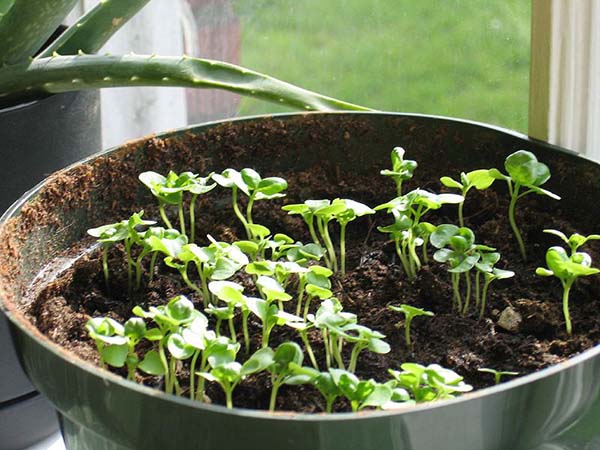
About a week after germination for better growth, young seedlings can be fertilized wood ash, having prepared a solution at the rate of 10 grams of ash per 1 liter of warm water.
Watering is recommended only after the top layer of the soil has dried, and in no case should it dry out. For irrigation, use slightly warm water at room temperature.
Note! Excessive moisture can damage the basil black legtherefore it is important to ensure that after watering, excess water does not stagnate in the sump.
Video: caring for basil seedlings, watering
Picking
You can start diving for basil seedlings after the plant has 2 real leaves.
You can use the same soil mixture for picking, except add a couple of spoons (based on 5 liters of soil) into it wood ash and one spoon of a complex mineral fertilizer (for example, nitroammofoska), and then mix thoroughly.
By the way! So that the seedlings can be easily removed from the soil, the seedlings should be abundantly moistened before picking.
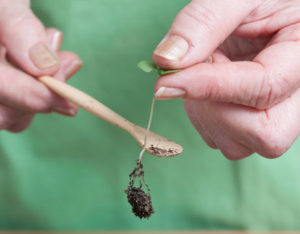
The basil pick is carried out according to the standard scheme: the containers are filled with earth, then compacted, depressions are made into which a young seedling is placed, earth is poured and the soil is slightly compacted again. Now it remains to complete the final watering.
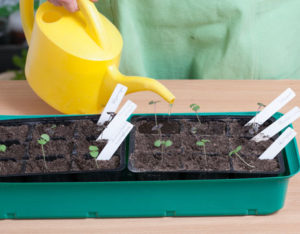
Important! After picking, it is recommended to put the seedlings in a cooler place!
Video: basil picking
Leaving after a pick
Further care for basil seedlings after picking consists in regular watering, several dressings and the obligatory pinching of the shoots.
Top dressing
If the basil develops normally, the seedlings are usually fed for the first time only after picking. For this, a complex nitrogen-phosphorus-potassium (nitroammofoska) fertilizer is used at the rate of 10 grams of the product per 1 liter of water. In the future, the basil is fertilized once every 2 weeks.
Memo! Nitrogen stimulates the growth of leaves, while phosphorus and potassium have a positive effect on the content of essential oil in the green mass.
It is worth remembering that basil develops quite moderately at the beginning of its growth, so you should not rush it unnecessarily and constantly fertilize it. An excess can be much worse than a seedling mineral starvation.
Pinching
When the 5-6th true leaf appears at the basil, it is recommended to pinch the shoots. So the greens will not stretch, but will begin to branch better and give more fragrant leaves. Actually, this is the main purpose of growing basil, isn't it?
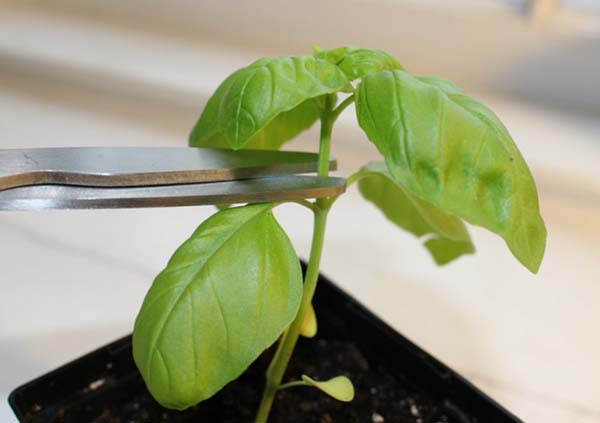
You will need to pinch the basil again when it begins to bloom. In addition to flowers, you should pinch a few leaves under them.
When and how to plant basil seedlings outdoors
10-14 days before planting in open ground, basil seedlings should be taken out into fresh air or a balcony for hardening.
As a rule, the date for planting a basil in open ground begins when the earth warms up to 15 degrees, that is, it falls on May-early June, depending on the climatic zone of the region.
The place for growing basil is chosen as illuminated as possible and protected from cold winds.
However, there is often not enough warmth in the Middle Lane of the aromatic spice, which is why it grows slowly. Therefore, you can plant it in a greenhouse or in a temporary mini-greenhouse made of a covering material stretched over small arcs. An even simpler solution would be to shelter the newly planted seedlings overnight.
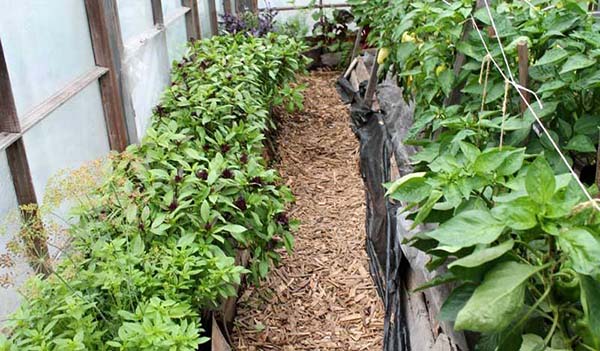
Planting basil next to peppers, tomatoes, or cucumbers is helpful. So the neighboring plant, due to its phytoncidal properties, will be under reliable protection from various kinds of insects and pests (for example, from the same aphids).
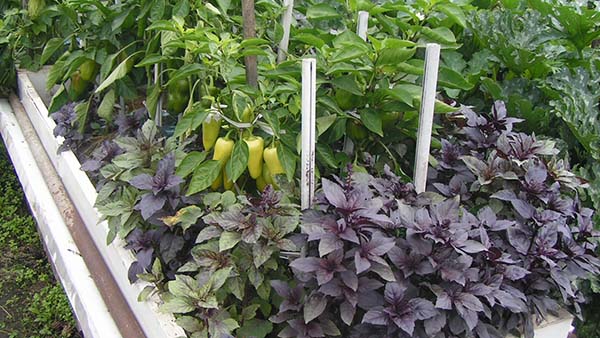
Basil will grow well only on light, airy and nutritious soils: clay and infertile soils will not work for it. Therefore, before planting, add some humus or compost to the soil, as well as sand and peat if it is excessively clayey.
Basil seedlings are planted directly with an earthen clod.
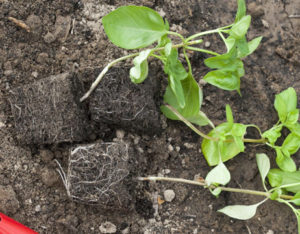
The distance between adjacent bushes should be 25-30 cm for tall varieties, 15-20 cm for more compact varieties. Leave 20-30 cm between rows.
Immediately after transplanting to the garden, the bushes should be watered abundantly.
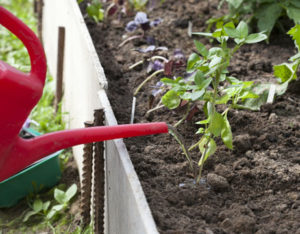
By the way! You can grow basil on a windowsill, read more about it in this article.
Video: planting basil seedlings in the garden
Caring for basil after planting in the ground
Further care and cultivation of basil in the open field in the garden includes regular watering, feeding and loosening the earth.
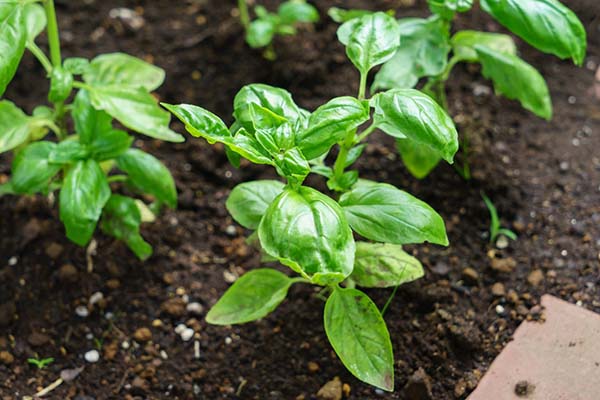
In order for basil to rapidly overgrow with fragrant green leaves, it needs a large amount of life-giving moisture, which means that watering should be regular and abundant.
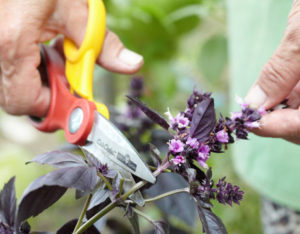
The factors contributing to the active growth of green mass are also timely pinching of peduncles and feeding nitrogen fertilizers, which should be carried out at least once every 4-5 weeks.
Reminder! Nitrogen fertilizers stimulate the growth of green mass in all plants.
If you follow these recommendations exactly, then the basil will develop well and give a lot of healthy greens until the first frost.
Advice! The more often and more you pull off the leaves, the sooner new ones will appear.
Thus, cultivating the excellent spice of basil through seedlings right up to the first harvests requires attention, accuracy, and patience.
Video: growing basil from seeds - from seedlings to planting in open ground

